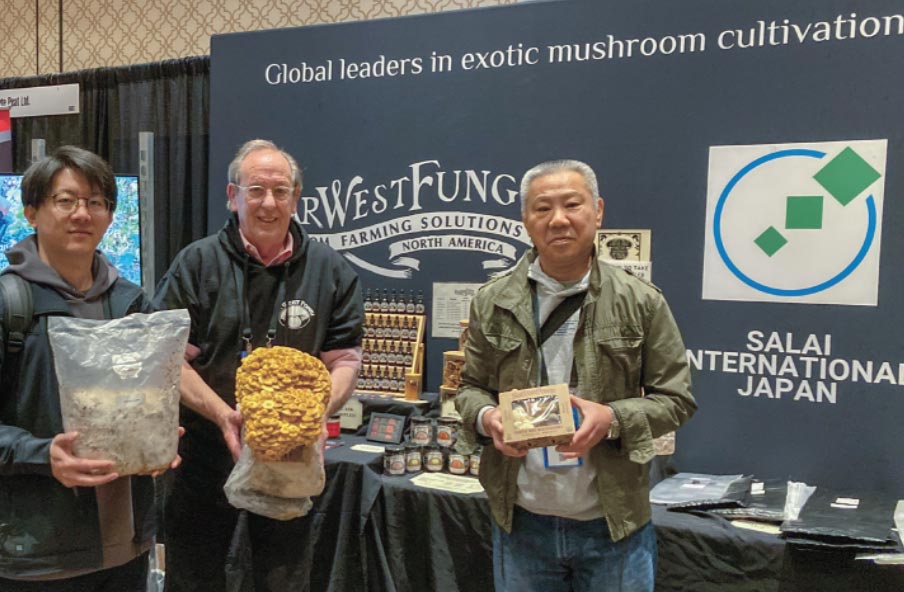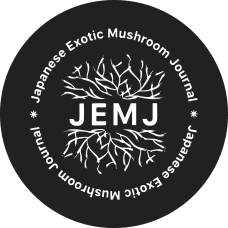Login or Subscribe
You must be logged in to access this content
Subscribe for free access to Japanese Exotic Mushroom Journal and gain insider knowledge on effective cultivation methods for Japanese mushroom species. Elevate your skills with expert tips and innovative technologies to master the art of growing Japanese exotic mushrooms.
◆ Discover exclusive Japanese mushroom cultivation techniques
◆ Learn innovative methods to enhance mushroom quality and yield
◆ Tap into Japan's rich heritage for unique growing insights
◆ Discover exclusive Japanese mushroom cultivation techniques
◆ Learn innovative methods to enhance mushroom quality and yield
◆ Tap into Japan's rich heritage for unique growing insights
Subscribe Now for Free Login
Impressions from the 2024 North American Mushroom Conference
Mushroom Industry Updates
Introduction
In February, I had the privilege of attending the first NAMC since 2019. It was my very first time at the event, so I came in without any concrete ideas of what to expect. This year’s 26th NAMC also jointly hosted the 20th Congress International Society for Mushroom Science, which meant there was great turnout from those in both the business and research sides of the mushroom world. Hosted in J.W. Marriot Hotel in the western end of Las Vegas, Nevada, the 2024 NAMC left a couple of big impressions on me.
1) The industry is attracting tons of new actors
One of the first things I noticed was all the of the companies, services and attendees who were otherwise relatively new to the mushroom business. Whereas for a long time, button mushroom farms growing Agaricus bisporus on compost were the only players in the mushroom business, save for a handful of serious exotic mushroom farms, I noticed that nearly half the attendees and stands this time came from the exotics sector.Having the innovative start-up Ecovative and their CEO and Co-Founder Gavin McIntyre as a Keynote Speaker set the tone for an NAMC that was very diverse in tone and subject matter. I had come in with only the Dutch Mushroom Days for comparison, where, I had found, despite a substantial investment from a number of Chinese and Korean companies to showcase equipment, and a few other stands associated with exotic mushroom farming, that the temperature in the room was very chilly and the interest from guests was light. Outside of a few existing clients and contacts, most people who passed by our stand took a copy or two of the magazine, asked a few polite and often puzzled questions, and then went on their way. I couldn’t help but compare the scene at the big Agaricus business stands at Mushroom Days, which was comparable to a crowded floor party at a popular club.Thus, the NAMC surprised me this year with the fervor and interest in exotic mushrooms, providing, perhaps, a personal anecdote to the existing market information showing that the number of farms and the sales volume of domestically grown exotic mushrooms is growing much faster in the United States than in Europe, with more cultivated species and more tonnage. One moderator, David Law of Gourmet Mushrooms, even noted in his introductory remarks that official figures do not account for farmer’s market sales, which he estimated, on the low end, to be about fifty million USD annually for the exotic mushroom sector, and which form the bread and butter of many small local exotic mushroom farms.While ultimately, the NAMC is a conference and not an expo, and thus the set-up and formats are fundamentally different, I felt the event represented different approaches and different cultures in North America and in the Netherlands. Both events however, remind an attendee that this is a truly global industry, with multiple stands from major Chinese companies, all of the big players in the spawn market, including Sylvan and Lambert, present, and a host of subcontractors and suppliers present as well. The mushroom business has a bigger footprint, and both impacts and supports a larger number of companies, than its raw revenue suggests. This is a complex, multi-faceted business with a major economic impact, but one which is, among agricultural industries, remarkably ecological sustainable and low impact.Even more experienced attendees who had been to multiple prior NAMCs told me that this was the first time they had seen so many people from outside the industry attending. From retirees looking to set up a small exotics farm for local distribution, to ambitious young people doing research into potential start-up opportunities, many new people interested in mushrooms attended despite the significant fees involved. This just showcased how widespread and growing the public interest in this sector is, and what a unique opportunity this period in time is.- 2) The exotic sector is boomingWhile I am also wary of the typical boom-bust cycle in the agricultural sector, I think it is safe to say that exotic mushrooms are booming. Domestic production in America is increasingly rapidly right as consumer interest is rising. So far, prices have held up well, and in the meantime, many farms are automating and modernizing. I think what is happening in this sector in America is a good example of the usefulness of Japanese systems (even if I am biased here); namely how they combine enormous flexibility, adaptability, and scalability with reasonable price points and exceptional machine fabrication standards. As Kasper Moreaux of Mycelia said during the panel discussion on exotic mushrooms, many Europeans are coming more around to the Japanese model after having tried other systems with mixed results.But no matter who I talked to, including the older, more established players in the exotics sector, there was a common thread. Farms that can produce consistently and with efficient machinery in place, are doing good business. Many are expanding, even in the UK and Europe. As a result, it’s not just small start-ups taking a second look, but many of the big players who are based in Agaricus cultivation are also starting to reevaluate their approach to exotic varieties.
I was happy to attend and man the joint booth for Far West Fungi and SALAI International Japan. Over the course of the whirlwind four-day conference, I nearly lost my voice from talking, at high volume in order to be heard amongst the bedlam, all day long each day. We were flooded with people interested in exotic mushroom farming, and with existing clients coming by for a chat. Far West Fungi’s mushroom extract functional gummies were a huge hit; sometimes we even had a line of people waiting to try them.
3) The NAMC offered a complete bird’s eye view of the sectorI felt that the NAMC offered a very complete view of the mushroom sector. Not only did this year’s conference include researchers from around the world, but on the business side you had agro-waste dealers, supplements, substrate dealers (for both button mushrooms and exotic varieties), spawn companies, consultants, packaging systems, and of course, representing the myco-materials sector, Ecovative, all present in the same building. The American Mushroom Institute and its partner in this event, the International Society for Mushroom Science had an exceptionally even-handed approach in giving all of these different elements their time under the spotlight in the form of Keynote Speakers and panel presentationsThis was very useful and interesting because it gave me an opportunity to, during meals and whenever I had a rare moment of free time, buzz around like a bee from flower to flower. I could see what everyone was doing, what’s trending, who’s a big player in what sub-section, whose supplying who_emdash_to see all these little movements going on in the industry in a way that made it easy to grasp their impacts.I met many people who I only knew as names in the industry journals like Mushroom Business or Mushroom News, and ran out of business cards early. There was definitely a sense that attending the NAMC is a necessary part of the business; one that shows commitment and that you and your business are serious players. The mushroom business is very serious, and like all agricultural businesses, it relies on a delicate balance. Even when the profits are great, a slight upset in some of the components, an increase in fuel costs or a labor crunch or a raw materials shortage, can instantly send even the best run operation into the red. I was impressed by how dedicated and hardworking everyone was, and doubly determined to continue learning and better support the sector from my position in Japan, both through educational materials like this journal and our direct work with our American distributors, Far West Fungi and clients from around the world who come to us for information on exotic mushroom farming and to supply equipment and growing materials. - ConclusionThe mood at the 26th NAMC was one of optimism_emdash_for many cautious, but still optimistic. For button mushroom farmers, there was a sense that the intense turbulence of the past four years was starting to settle down. Great progress has been made in researching peat alternatives and there have been a number of other interesting innovations in growing technology for button mushroom farms in the past five years. The use of machine-learning systems to power more sophisticated automated harvesting systems shows potential to finally solve one of the biggest labor issues for button mushroom farms as well, after decades of false starts and failed products.Many on the exotics side were excited for what the next few years will bring. It’s not like growing exotic mushrooms is sunshine and daisies, and the problems are completely different from button mushroom farms. One pressing issue most face is that there isn’t any real, established, professional infrastructure for growing exotic mushrooms the way there is an extensive industry built up around supporting button mushroom farming at commercial scales. But there is also a lot of passion, a lot of new people who have chosen this industry, who believe in it from an ethical, environmental perspective, who view their work as doing a social good and also providing an important healthy food source for their communities.The experienced reinforced my desire to create a diverse and stable industry where growers at all scales can thrive, partly by providing the resources and expertise for those growers. I saw the great potential in the North American market in the years to come, built on the personalities, hardworking and idiosyncratic, that are building a grassroots base for new foods. Mushrooms, I heard it said more times than I can count, are the future. Or, in another, more alliterative version, the future is fungi. Aside from the other numerous applications of fungi in medicine and recycling, as a food source, edible fungi, whether they be button mushrooms or lion’s mane mushrooms, offer a water-efficient, low-emissions year-round crop with stable yields, and which produces remarkable and healthy food with immunomodulating and cholesterol-lowering properties while recycling other lignocellulose waste streams. It is an exciting time to be in the business, and I hope to have the chance to see where things stand come time for the next NAMC.~Jake Waalk, JEMJ Chief Editor






 1-2-13 Honmachi, Komoro city, Nagano prefecture, Japan 384-0026
1-2-13 Honmachi, Komoro city, Nagano prefecture, Japan 384-0026